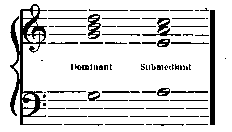Harmony Book For Beginners - online book
Scales, Intervals, Common Chords, Dominant Seventh Chord and Melody Making.
| Share page | Visit Us On FB |
|
64 |
OREM'S HARMONY BOOK |
||
|
Half Cadence. The Tonic Chord followed by the Dominant Chord (in any Position).
Example:
Scale of C. Half Cadence. |
|||
 |
|||
|
Deceptive Cadence. The Dominant Chord followed by any chord, other than the Tonic. |
|||
|
|
|||
|
Example: |
Scale of C. Deceptive Cadence. |
||
|
|
|||
 |
|||
|
These Cadences all have their uses and a mastery of them will aid the student greatly in harmonizing melodies, in harmonic analysis, and later on, in attempts at elementary composition.
The Perfect Cadence implies a full close; hence it must be used but rarely, except for this purpose. The Imperfect Cadence, while it may be used for a close, is less final than the Perfect Cadence; hence it may be employed more freely. The Plagal Cadence (gidemise or collateral), while it is sometimes used for a close, may be employed at will. The Half Cadence invariably indicates something to follow. It avoids a close. The Deceptive Cadence is also used to avoid a close. Both these latter are employed freely.
As an Exercise, let the student write out, in the following given spaces, the Perfect, Imperfect, Plagal, Half and Deceptive Cadences, in each of the Scales indicated, using all the Positions as given in our Examples for the Scale of C.
Scale of G: |
|||
|
|
|||
 |
|||